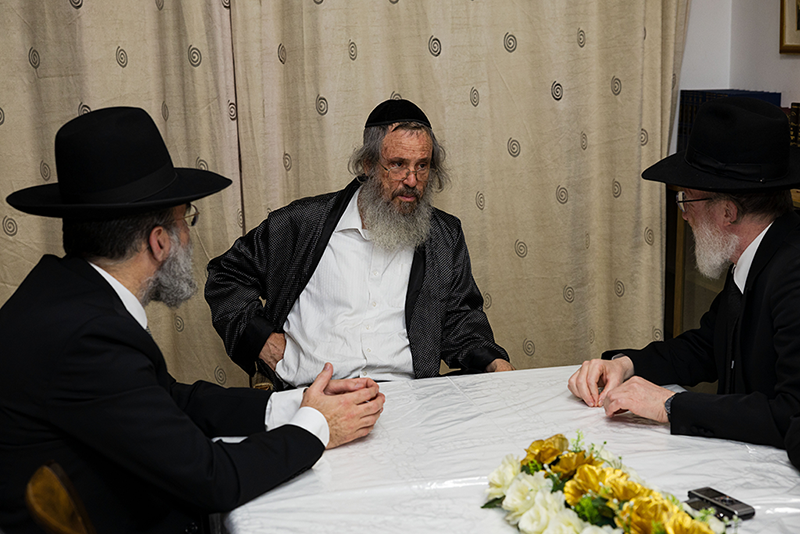On Motzoei Shabbos Parshas Chukas a small group of marbitzei Torah was zoche to visit the home of HaGaon HaRav Dovid Cohen, shlita, Rosh Yeshivas Chevron. The fascinating conversation about derech halimud in the yeshivos of yesteryear and those of today contained many important lessons and much guidance for bnei hayeshivos from one of the gedolei roshei yeshiva and mosrei hamesorah.
The question of how much time one should spend on iyun versus bekius is a question with which many bnei yeshiva grapple. On the one hand, we understand that certainly in morning seder, learning should be devoted to complete immersion in iyun with yegias haTorah, delving into the sugya with the rishonim, acharonim and shiurim from the roshei yeshiva. The question then arises: What method of learning should be done for the rest of the day? Does it depend on each individual? In short, what is the proper balance between iyun and bekius and if bekius is learned, how should it be learned?
HaGaon HaRav Dovid Cohen, shlita: Let me tell you how we learned in Chevron when I was a bochur and how we learn in the Chevron Yeshiva today. We learned from Rav Meir Chodosh, zt”l, Mashgiach of Chevron, that in bekius seder we must learn five blatt a week! That is what he constantly demanded from us. I must admit that Rav Meir was upset with me because I only managed to learn four blatt a week. I couldn’t get to five.
This was the Gemara with Rashi and Tosafos?
Yes, of course. We also at times learned a bit of Rosh and Ran.
When did you learn bekius in Chevron?
The seder hayom in Chevron was as follows: morning seder was completely devoted to iyun. The roshei yeshiva would deliver shiurim on what we were learning in the morning. Afternoon seder AND night seder were both devoted to bekius.
That is how we were able to learn four or five blatt a week. We spent the entire afternoon seder and night seder on bekius. In my time, afternoon seder went from 3:00 p.m. until 7:00 p.m., and night seder went until late at night. I remember how Rav Aviezer Piltz (today rosh yeshiva of Tifrach) would run to eat supper after Maariv and would be back in the bais medrash a few minutes later. He would then continue learning at night seder for four or five hours. That was how a rosh yeshiva like Rav Aviezer grew to become what he has become. He didn’t waste his time and he spent a lot of time covering ground, not just in a superficial way but with Tosafos, some rishonim and many chazaros.
Is this the current seder hayom in Chevron?
Second seder is still completely devoted to bekius. We were not able to sustain learning bekius for night seder. That has changed. Nevertheless, we still demand that bochurim learn bekius and cover ground with constant chazaros and tests.
Did Rav Meir Chodosh demand that the bochurim finish the entire masechta that the yeshiva was learning?
That was not Rav Meir’s nussach. Rav Meir always spoke about the fact that a Yid needs to learn Shas! He more than once asked me, “What is your plan to learn Shas? Do you have a plan?” He always spoke about the concept of learning Shas. He demanded five blatt a week. I remember when I told him I could only do four, and he said “Nu, nu…” That was a sign that he was not pleased.
Does the Rosh Yeshiva think there is a maalah in finishing the masechta?
Certainly, there is a maalah to finishing the masechta but that is not what I am talking about. What I am talking about is that the most important thing is for bnei yeshiva to learn how to learn. One cannot learn how to learn without learning many blatt gemara.
Is the Rosh Yeshiva saying that learning bekius helps a person learn iyun properly as well?
Let me explain. A person has an obligation to know Torah. yedias haTorah. The Gemara says that divrei Torah are ‘aniyim b’makom echad v’ashirim b’makom acher” – in one place the Gemara is very brief and in another place the Gemara is more detailed. Thus, one Gemara sheds light on the other. The yedios that a person has help him understand what he is learning. Certainly it will help him better understand what he is learning in iyun seder.
When I was a bochur in Chevron, the yeshiva learned Bava Metziah. I was only able to do four blatt a week so in the end I did not learn the perek of Eizehu Neshech. I was unable to complete the masechta. Still, Eizehu Neshech is a separate inyan. I was able to be koneh the rest of Bava Metziah. Every Friday and Shabbos, we would chazer. We chazered over and over again until we had a kinyan in Bava Metizah.
What is the nature of the bekius program in the Chevron Yeshiva today?
During afternoon seder the bochurim are obligated to learn bekius, Gemara, Rashi and Tosafos. There are many talmidim who are able to complete four blatt each week. We have a very large group of talmidim who participate in the Dirshu Bachurei Yeshivos program and take tests every month on what they learned that month. They are also periodically tested on what they learned in pervious months. The constant chazaros and test taking enable them to come out with a kinyan in so many dafim of Gemara.
Does the Rosh Yeshiva deem it to be beneficial for the bochurim to be tested on what they learn?
Yes. When a person gets tested, he has a mechayev. The simple explanation is that when a person does not take tests, he does not feel truly obligated to learn, chazer and actually know and remember what he learned. I think tests are a tremendous to’eles. No one should underestimate or minimize the to’eles of a test. That is why I encourage bachurim to join the Dirshu program.
What was Rav Meir Chodosh’s response to the bochurim who did not comply with his demand to learn bekius?
He was not happy, to say the least. Today, however, there seems to be some new ideology that some are creating of justifying the learning of iyun all the time without learning bekius at all. This is not new. For years, there have been some in yeshiva that ascribe to this idea. I must say that this is against the entire derech that all of my rebbeim where mechanech me in yeshiva. I was taught that you need both. You need a strong iyun seder together with a strong bekius seder in the second part of the day.
Rav Menachem Ben Menachem, a grandson of Rav Isser Zalman Meltzer, told me that his zeidah, Rav Isser Zalman said that in Volozhin there were also those who only learned iyun. There were others who only learned bekius. However, the ones who grew into gedolei Yisroel, Rav Isser Zalman concluded, were the ones who learned both iyun and bekius.
So, to grow into a gadol, you need iyun and bekius?
Yes, and I was taught that bekius means five blatt a week…
Does the Rosh Yeshiva see a difference between the bochurim who participate in bekius programs and take tests, such as Dirshu, and those who don’t?
Absolutely. I must say that in my opinion, programs like the Dirshu Bachurei Yeshivos program are hatzolas nefashos. The bochurim learn, they chazer and they take tests. These are not “Daf Yomi” tests. They are tests that ask comprehensive questions to make sure that the bochurim learned the sugyos properly. One who learns superficially will not be successful. We have a very large tzibbur in our yeshiva who participate in the program and take the tests. You can see the difference on them. They are so happy. They have such sipuk. They feel so accomplished.
I feel that this is the hatzolah of Klal Yisrael. I think about this all the time. We have boruch Hashem been zoche to see a generation where there are so many yungeleit, ameilei Torah who sacrifice their lives for Torah. They live in poverty, without proper parnossah, but sadly in a way they are not utilizing their time properly. They do not end up emerging as talmidei chachomim because they keep on learning the same few blatt b’iyun. Some are only able to learn three blatt a zeman. This is not the correct approach. It is a siluf, (distortion).
Perhaps when it comes to bochurim in a yeshiva, there is a bit of teretz, a justification. They are learning how to learn. They are learning a derech halimud, but avreichim, yungeleit? Now is the time to sit and learn, not learn how to learn! There is no justification for a yungerman to learn only three blatt a zeman. Chewing over the same thing again and again, the same yesodos, results in a person emerging with almost nothing.
A true talmid chochom is someone who can be asked a halacha in any place, and he is able to answer. Nashim, Nezikin, Moed, Kodshim, Taharos!
I see that those who have sippuk, those who are truly happy and feel satisfied are those bochurim who learn both iyun and bekius and are tested on their bekius. This elevates them, filling them with geshmak and sippuk in learning.
Does the Rosh Yeshiva think that more yeshivos should participate in programs that have goals and tests?
Of course. This is very important. There are already thousands who do learn this way, but it is definitely something that the entire olam hayeshivos can emulate. We must return the Torah to its former glory.











